Flashbulbs
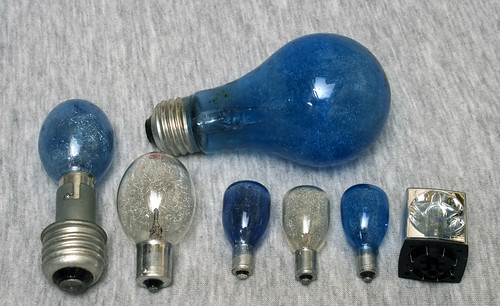
|
| top: GE 22B from left: Westinghouse 6B in Mazda/Edison adapter, GE 5, Sylvania M3B, Sylvania M2, GE M2B, Sylvania Flashcube image by Jack Hufnagel (Image rights) |
Flashbulbs provide light for photography where there is insufficient "available" light, using the confined combustion of fine wires or foil within a glass capsule.
Contents
Origins
Before flash bulbs, flash photography relied on openly burning powder - usually containing magnesium. In 1893, Chauffour made an ancestor of the flash bulb;[1] this had magnesium ribbon in a glass bulb, and was fired electrically- but this had been designed for underwater photography. The first recognisable flash bulb for general use was invented in 1925 by Vierkötter - using flash powder in an evacuated light bulb, fired by a lamp filament.[2] Later that year, Vierkötter made a low-pressure oxygen-filled bulb. There are conflicting reports of the first commercial bulbs - made either by General Electric in the US, c.1927, or the Vacublitz aluminium foil bulbs made by Ostermeier in Germany, c.1929. The first wire-filled bulbs are reported to have been made by Philips in the Netherlands, in 1934.[3]
Flashbulb Characteristics
Flash bulbs are individual, disposable items--used once, then discarded. These are fitted into a flash gun, which may be built-in to the camera, or an add-on accessory. Bulbs improved on earlier flash systems by safely enclosing the material which could otherwise throw burning embers over the subject and emit large quantities of smoke. Bulbs contained various materials, often magnesium or aluminum wire or foil. Small amounts of highly explosive zirconium paste are typically used as the means of igniting the magnesium or aluminum primary combustible materials.
Early bulbs resemble domestic light-bulbs, including a metal base with a screw (ES/Edison Screw, or "Medium" base)--these include the common "Press 40" bulbs of the 1930s and 40s. By the end of the 1930s a new type of "midget" flashbulb was introduced that uses a bayonet (BC/Bayonet Cap) fitting. The No.5/No.25 became the standard bulb in this size and remained extremely popular through the 1940s and 50s, and continued to be sold up until the 1970s. In the early 1950s, in an effort to further reduce the size of bulbs and the equipment needed to fire them, the "miniature" M2 and M3 bulbs were released, which use a smaller bayonet fitting than the No.5 bulbs. In the late 1950s and through the 1960s the even smaller "capless" bulbs such as the AG-1 became popular as flash equipment continued to become smaller and more compact. Capless bulbs do not have a separate base, but instead provide wire contacts emerging directly from the glass, omitting the base.
By the end of the 1940s most bulb designs incorporated lacquer or plastic coatings to prevent bulbs from shattering. Although relatively effective, many flash units continued to be sold with special shields designed for use when using flashbulbs for close-up portraits, as an added safety measure. One particular cause of bursting is cracking and subsequent leakage of air into the low-pressure oxygen of the bulb; to reduce the chance of this, most bulbs had a blue indicator spot on the inside, which would change to pink if exposed to normal air. Use of this blue spot was continued in flashcubes & magicubes.
Prior to around the mid-1950s all flashbulbs were clear, and emitted light with a color temperature around 3800K. Clear bulbs work well with black-and-white or tungsten-balanced color film, but are not well suited for use with daylight color film. As color film became more readily available after World War II, to use clear flashbulbs with color film required that the photographer use a blue filter either on the camera lens or on the flash unit itself. Many flash units were sold with blue accessory covers for use with clear bulbs and color film. As color film became more popular through the 1950s, new flashbulbs with blue coatings on the bulbs themselves became available to reduce the hassle of using additional filters for color photography. The downside of the blue-colored bulbs is that their output is generally cut by about one-half, or one full stop.
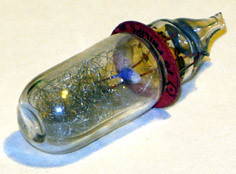
|

|

|
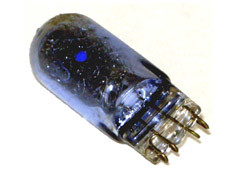
|

|
| A flashbulb without metal base by AWCam (Image rights) |
Common M3 flash bulbs by Peter M Lerman (Image rights) |
An older, larger General Electric bulb, in a flashgun on a Minolta 16 II by Nick Zamora (Image rights) |
An AG3B bulb, about 1 inch (2.5cm) long, showing blue coating & blue air-leak indicator spot by AWCam (Image rights) |
Foil-filled bulbs. The large one is a Sashalite by GEC England by Geoff Harrisson (Image rights) |
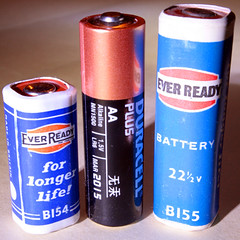
|
| 15v (left) & 22.5v (right) flash batteries, with 1.5v AA battery in center for comparison image by AWCam (Image rights) |
Triggering The Flash
Prior to around 1951, virtually all flashguns were simple direct-battery triggered units powered typically by either two 1.5V AA cells (known as "penlite" cells at the time) or two 1.5V C cells (known as "flashlight" cells at the time). In the early 1950s a new type of flash system known as the "B-C" unit became available, "B-C" standing for “Battery-Capacitor”, or sometimes, rarely, “Battery-Condenser”. Throughout the 1950s both types of flash units were sold, and many very popular flashguns such as the Kodak "Flasholder" guns were capable of running either on direct battery power or with a B-C insert. There are advantages and disadvantages to each type.
Battery-only advantages:
- Batteries are relatively cheap and very easy to purchase almost anywhere
- Battery circuits are incredibly simple and more servicable
- Batteries can be used with solenoid synchronizers (important back in the days before internal synchronization was commonplace)
B-C advantages:
- A consistently large supply of current is available from the capacitor even as the battery gets weaker
- The B-C system works best for multiple flash setups
- Because the capacitor drains off small amounts of current, aging of the battery has little effect on the B-C system
- The battery used in a B-C system can give a much longer life than those used in battery-only systems, often several years
The main disadvantage of the B-C system during that period was that the initial cost of the B-C system was far higher than a battery-only system (also B-C systems could not be used with solenoid synchronizers). In all other respects the B-C system is far more reliable, and provides longer battery life, than a battery-only system.
A flashbulb is ignited primarily by high current, not high voltage. A standard 1.5V battery can provide the short burst of high current needed (usually two batteries for 3V), but batteries quickly lose the ability to reliably provide that burst of high current as they age. On the other hand, an equivalent B-C unit uses a small, high-voltage battery that provides a low current to charge a capacitor, which then in turn provides the high current during flash. Typical high-voltage batteries of the 1950s and 1960s were either 15V or 22.5V. These specialized batteries are no longer manufactured by the big battery companies and are difficult to find today.
Many popular flash units of the 1950s could be run either with batteries only or with special B-C inserts offered by the flashgun manufacturer. In the late ‘50s the Mallory battery company (which became Duracell) even sold special B-C “conversion units” that were the same size as common battery configurations, which could be used in any non-capacitor flash unit. These units allowed owners of flash units whose manufacturers did not offer a factory B-C option the ability to take advantage of a B-C power source.
In the 1950s and 1960s there were also special "Photoflash" batteries made especially for use in flashguns. These batteries were identical in shape but used different chemistry than regular batteries at the time. The photoflash batteries were formulated for short bursts of high current, while regular batteries were formulated to provide longer life of constant use at a lower current. Once the far-superior alkaline batteries became readily available in the late ‘60s and early ‘70s, the special photoflash batteries disappeared from the market.
By the early ‘60s most mid-range to high-end flash units had gone to a built-in B-C system. There are many reasons for this: the costs of the B-C systems were coming down as capacitor manufacturing improved; photographers were beginning to use much longer rolls of film as 35mm film became much more popular, requiring more reliable firings of flashbulbs in quick succession; and flash units in general were getting much smaller in response to consumer demands for smaller cameras, smaller flashbulbs, and more compact systems. Cheaper cameras continued to use battery-only flash up until the mid-‘60s, by which time cheap cameras had begun transitioning to flashcubes.
Virtually all disposable flash bulbs and systems have now been replaced by re-usable electronic flashguns. A very few photographers still use bulbs for special effects, or the sheer power that bulbs can produce; see, for example the flashbulbs.com link (below) for current usages and supplies.
Synchronisation
Flashbulbs need to be synchronised to the opening of the shutter. The most basic form of synchronization is known as "open flash", which was the only way to use flash systems prior to the mid-1930s and remained a reasonable option through the 1950s. With an "open flash" synchronization, the photographer simply opens the shutter, fires the flash manually, and then closes the shutter.
More sophisticated synchronization is achieved by automatic flash/shutter triggers that allow the flash to synchronize with the shutter at normal shutter speeds. A flashbulb does not reach its peak light output for some time after it is initially fired--this delay time is carefully controlled in order to allow consistent shutter synchronization from camera to camera. The most common flashbulb synchronization is "M-sync", which includes an initial delay followed by a "bell curve" light output over a controlled period of time. Using this synchronization delay as an example, this requires that the flashbulb be fired, then the opening of the shutter must be delayed to coincide with the peak output of the flashbulb. This synchronization delay can be effected in a number of ways.
In the mid-1930s flash/shutter synchronizing systems became available. At that time, most systems were aftermarket add-ons that used mechanical or solenoid triggers that were mechanically or electrically tied to the shutter button in some way. These required special adjustments by the photographer in order to get the synchronization timing correct. The 1935 model of the VP Exakta camera is believed to be the first camera to provide internal flash synchronization, via a special set of sockets on the front of the camera that a proprietary flash gun can be plugged into. In 1938 the Univex Mercury became the first camera released with internal synchronization via a "hot shoe" flash mount, followed closely by the Perfex Forty-Four in early 1939.
The synchronization of flashbulbs is very different than the synchronization of electronic flash, not only because electronic flash peaks almost instantaneously after triggering and thus requires no shutter delay, but also because the duration of light output of a flashbulb is much longer than an electronic flash. Flashbulbs generally produce far more total light output than typical consumer electronic flash units, but synchronizing a flashbulb is more complex.
Flashbulb types
- F - Fast bulbs, with time to peak approx. 5 ms and flash duration under 10 ms (at half peak), which could be used with X synch sockets of leaf shutters at speeds up to 1/100 s.
- X - a German class laying between types F and M, with time to peak of 10-18 ms and most common flash duration of 8-10 ms. These bulbs could be used with X synchronised leaf and focal plane shutters at speeds up to 1/30 s. This should not be confused with the far more common "X-Sync" used for electronic flash ("X" standing for "Xenon bulb").
- M - Medium speed bulbs, offering time to peak 18-20 ms and generally 8-12 ms flash duration.
- S - Slow burning high power bulbs with time to peak approx. 30 ms. Due to long flash duration (some 20-30 ms) S type could be used with leaf shutters at speeds not higher than 1/20 s, but had guide number significantly higher than other flashbulb types.
- FP - slow burning bulbs intended for synchronisation with focal plane shutters at faster shutter speeds. Although commonly referred to as "Focal Plane" bulbs due to their primary use with focal plane shutters, the letters "FP" originally stood for "Flat Peak", referring to the long duration of relatively even light they produced, which is beneficial for even exposure of a film frame when used with focal plane shutters at faster shutter speeds. Type FP had time to peak of approx. 30-35 ms and 25-35 ms flash duration at half peak, with relatively even brightness.
Multiple Systems
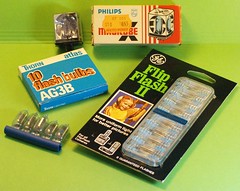
|
| image by Uwe Kulick (Image rights) |
These consist of a number of bulbs packaged together, with an automatic method of firing the next unused bulb. These were common on cheap, snapshot type cameras such as Instamatics and Polaroids.
Individual disposable flash bulbs had several disadvantages:
- Bulbs could be fiddly and slow to insert into a flashgun; the wire contacts could be bent and fail to connect, and the glass could break in the fingers. The gun itself may need to be opened and closed in addition.
- Once fired, the bulb needed to be ejected; at this point it was hot enough to have blistered the glass and burn anything it landed on, and could sometimes have shattered into small sharp shards as it fired. Often a guard had to be removed from the gun before the bulb could be removed.
- Taking another picture required the whole process to be repeated.
Various systems avoided these problems by enclosing multiple bulbs into a package - with some mechanism for automatically firing the next unused bulb. This keeps the glass and contacts away from fingers and allows rapid changes.
There were three major systems: Flashcubes, Magicubes and Flipflash.
Flashcubes

|
| Flashcube image by AWCam (Image rights) |
Flashcubes, introduced c.1966,[4] had four AG1-sized bulbs, on four sides of a cube, with a plastic reflector behind each. Flashcube cameras have a socket to insert the cube, and rotate it as the film is wound to bring the next unused bulb to the front. Cubes are fired electrically by lower-voltage batteries than most individual bulbs - use of two 1.5v batteries was common.
Magicubes
Magicubes (X-Flashcubes) were an improvement on flashcubes, introduced in 1970.[5][6] They looked almost identical to the original flashcubes, but were fired mechanically by a spring wire striking a capsule of fulminating primer. This simplified the system compared to flashcubes - by removing the need for a battery, and made extremely cheap flash cameras possible. Magicube sockets appeared similar to flashcube ones, but had a slightly larger slot and were distinguished by being marked with an X - similarly the cubes themselves usually had a large X on the top - and having a pin instead of electrical contacts.
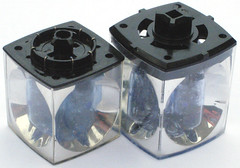
|
| Flashcube (left) with electrical contacts, slightly larger Magicube with holes for firing pin. image by AWCam (Image rights) |
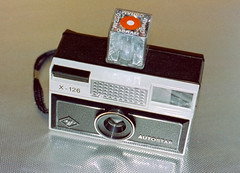
|
| Agfa Autostar X-126 with Magicube fitted image by Uwe Kulick (Image rights) |
Flipflash
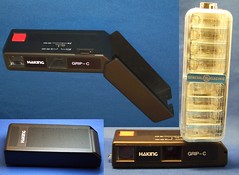
|
| Haking pocket camera for 110 film with GE Flip Flash II image by Uwe Kulick (Image rights) |
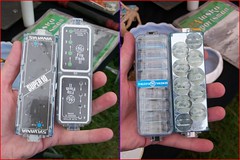
|
| GE and Sylvania styles of flip flash image by TheDamnМushroom (Image rights) |
Flipflash featured an array of 8 or 10 bulbs in a flat rectangular arrangement, each bulb placed horizontally, one above the other. Fuses selected the next bulb to fire; when half the bulbs were used, the photographer had to invert the Flipflash - which had a connector on both ends - to use the remainder (hence the name). The camera had a small rectangular socket to mount the Flipflash.
Flipflash was subject to several patents; to get around these, and to fit their own cameras, other manufacturers arranged theirs differently, and some had other names for the system:
Philips Topflash
Topflash was very similar to Flipflash, but placed the bulbs vertically, two per row in an 2×4 arrangement.
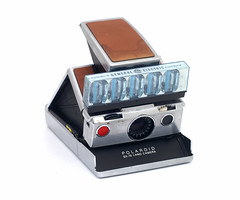
|
| Polaroid SX-70 with Flash Bar image by Steve Harwood (Image rights) |
Polaroid Flash Bar
Another Flipflash variation. 10 Flash Bar bulbs were placed vertically, and arranged next to each other horizontally. Both sides had 5 bulbs, the bar being rotated to use the other side.
Sylvania Flip Flash
Flip Flash bulbs were arranged in a zig-zag manner. Sylvania also made a Polaroid bar arrangement.
Notes
- ↑ Wightman, Eugene P., 'Photoflash' (archived), in Image, Journal of Photography of the George Eastman House, Vol. IV, No. 7 (October 1955), pp 49-50; reproduced as a pdf at GEH.
- ↑ British Patent 272394, Improvements in or relating to flash-light devices suitable for photographic purposes, filed 14 December 1926 and granted 16 June 1927 to Paul Vierkotter (spelt here without the umlaut), at Espacenet, the patent search facility of the European Patent Office. The article in Image magazine, cited above, refers to a German patent of 1925.
- ↑ Focal Encyclopedia of Photography, revised ed. 1969, Focal Press, London
- ↑ See a January, 1966, Popular Photography ad for the "revolutionary new" flashcubes (Vol. 58, No. 1; inside back cover).
- ↑ See the New York Times article "A New Flash Cube Is Introduced" By Gene Smith, June 25, 1970.
- ↑ The new flash system got a critical look in the October, 1970, Modern Photography (Vol. 34, No. 10; pages 98 & 130).
Links
- Flash (including photos of Instamatic adaptors) on Mischa Koning's Kodak Classics site
- Magicube & Flashcube Photos + Tech Data (archived) on Flashbulbs.com - a current flashbulb supplier! Data on other bulbs here too.
- Photos of Flipflash Assembly on protom.org
- Photos of Magicube Assembly on protom.org